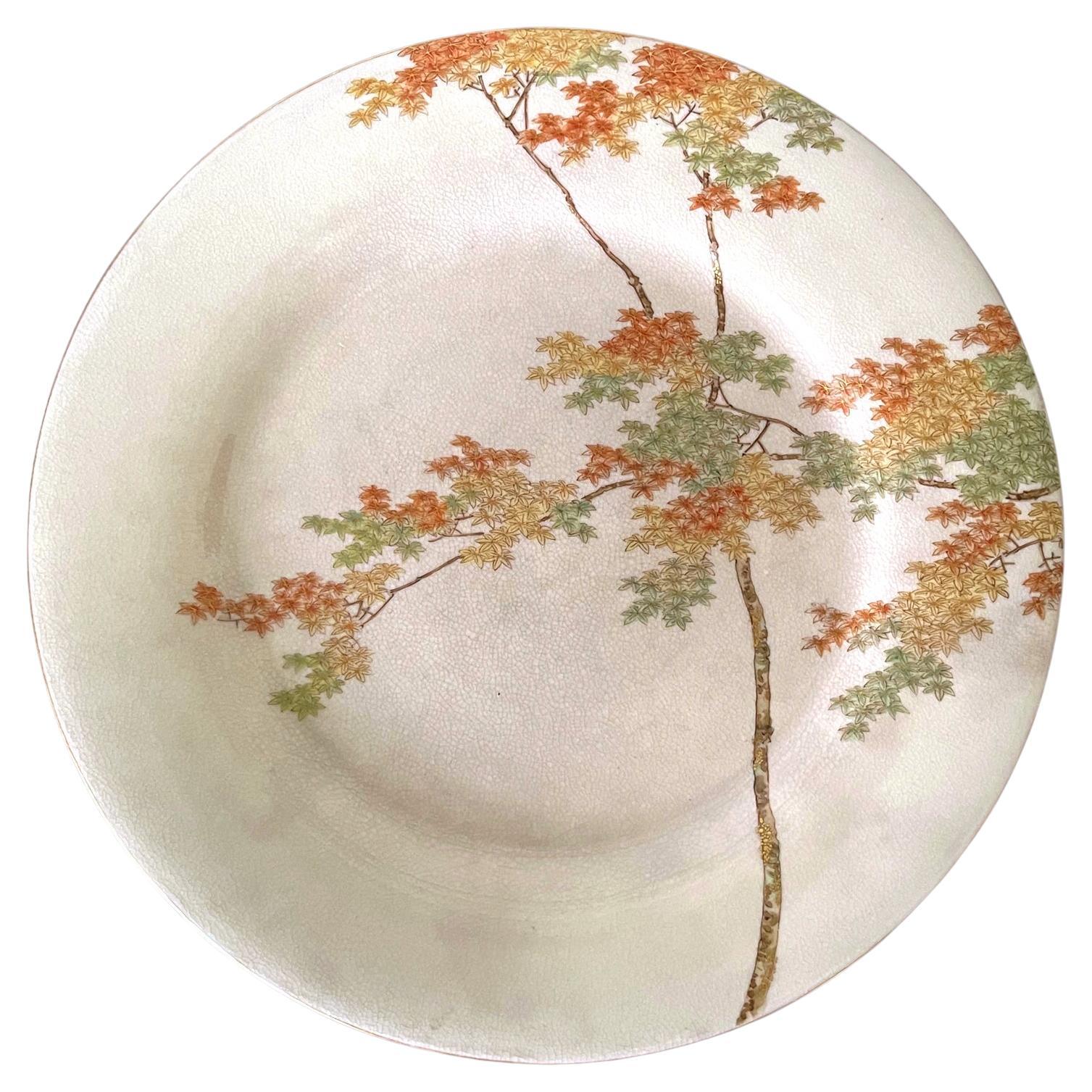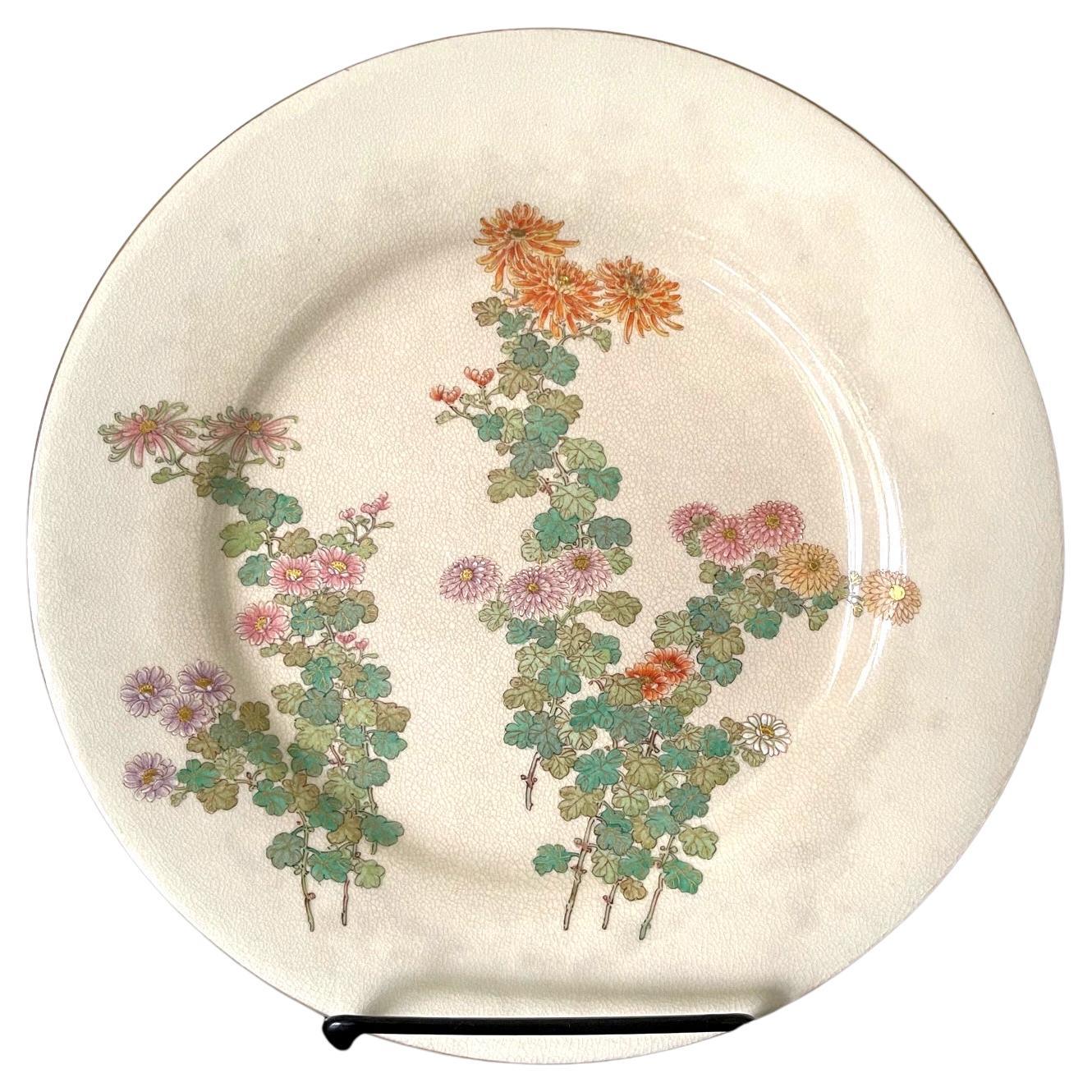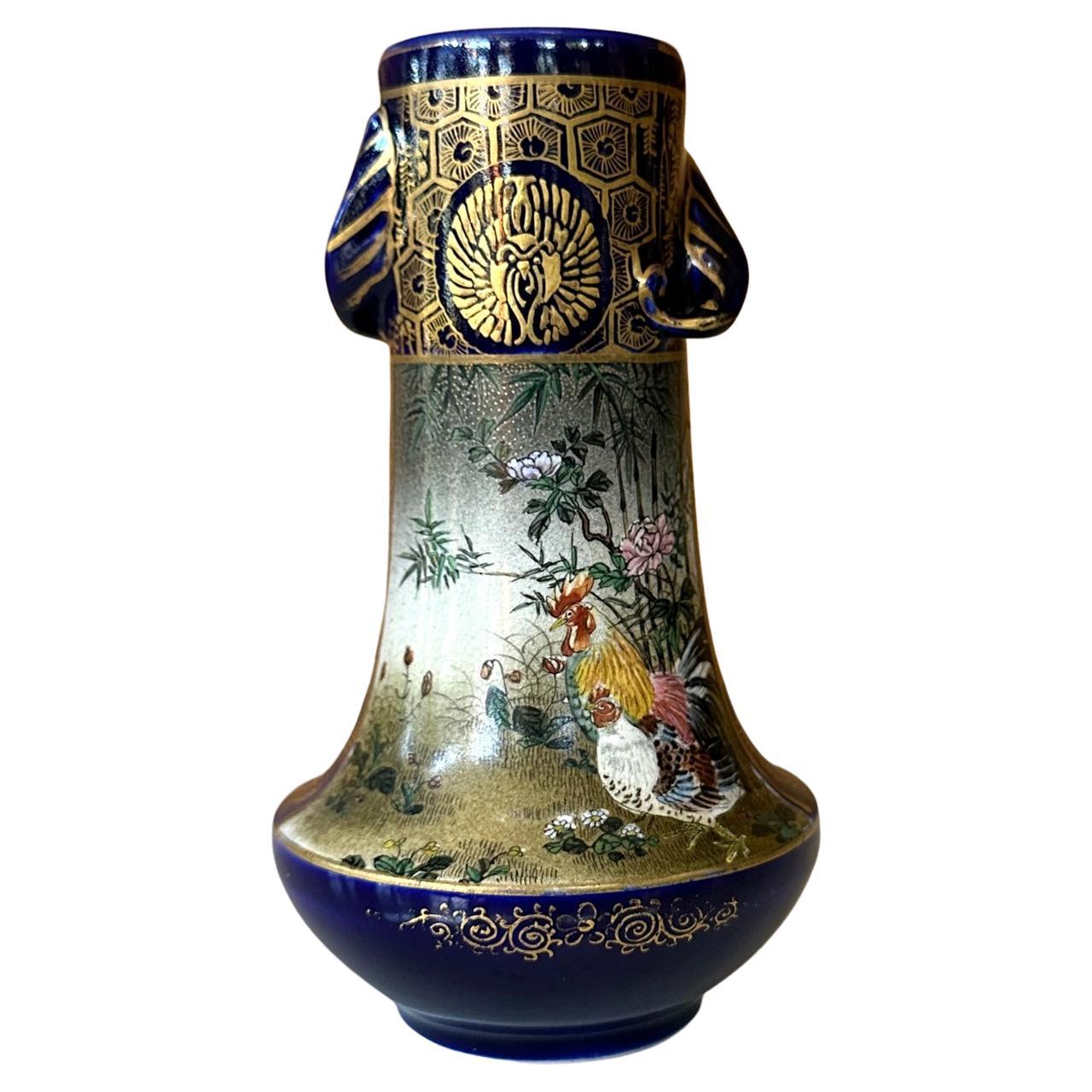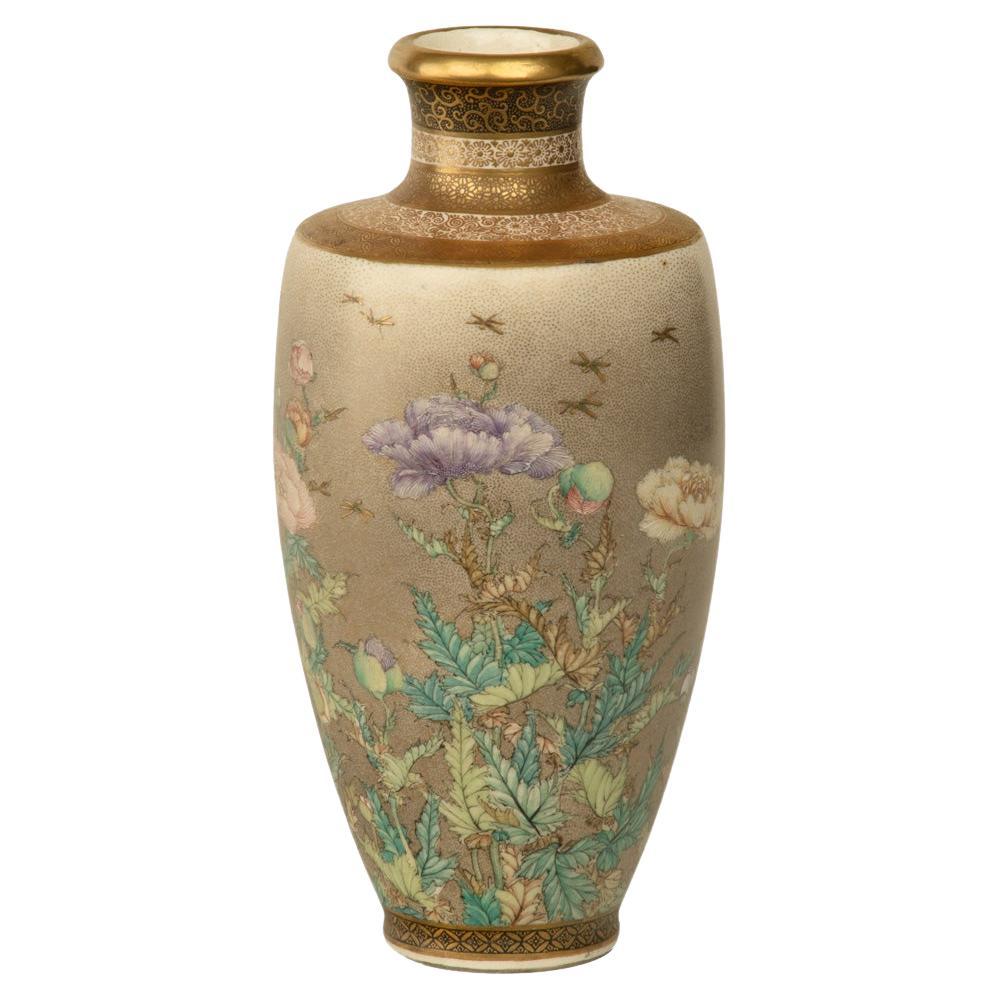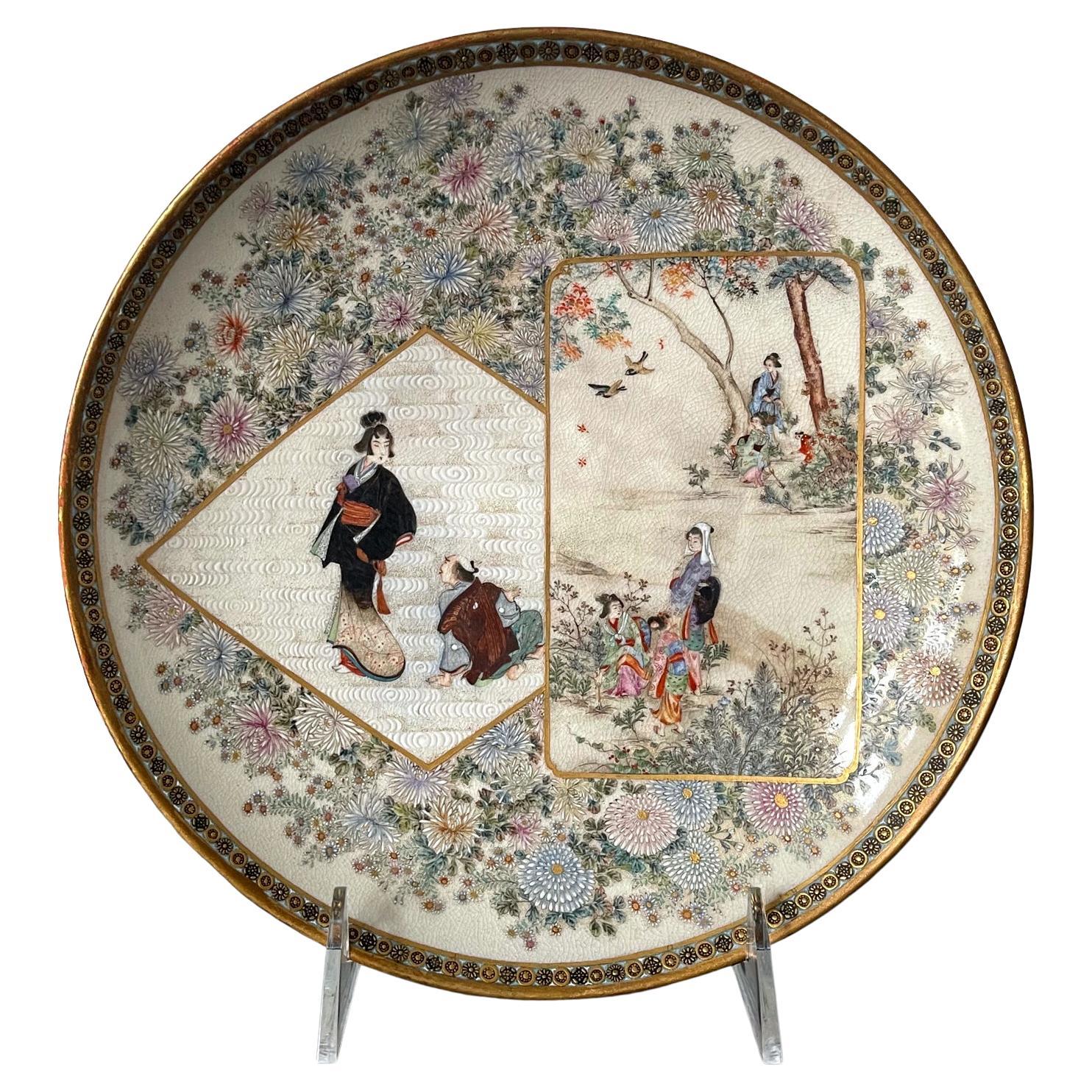Items Similar to Fine Japanese Ceramic Plate by Kinkozan for Yamanaka & Co.
Want more images or videos?
Request additional images or videos from the seller
1 of 13
Fine Japanese Ceramic Plate by Kinkozan for Yamanaka & Co.
About the Item
A fine Japanese ceramic satsuma plate made by Kinkozan and retailed by Yamanaka & Co. circa 1900-20s (late Meiji to early Tasho Period). The cream-color glazed plate features a very fine decoration of a persimmon tree bearing fruits. The composition is poetic, stylized but also realistic, with a literati painter's quality, and was advantageously enhanced by the enamel colorings in incredible details. The mastership of the medium came through the piece. It is signed on the base in gilt kanji seal (Made by Kinkozan) and branded Yamanaka & Co in English. The plate was likely commissioned by the company from Kinkozan for its various galleries in US and Europe.
The Kinkozan family established their pottery business first in 1645 and by the end of 19th century, it had become the largest studio producer of Satsuma ware. By the 1850s, Kinkozan Sobei (Kinkozan IV; 1824-84) started to export the wares to the west, particularly to America, together with the Kyoto manufacturer Taizan VIII. This continued and expanded under the leadership of Kinkozan V (1868-1927) until his death in 1927 when the studio closed.
Established by Yamanaka Sadajiro (1866-1936), Yamanak & Co was a large art gallery business with branches in New York (1895), Boston (1899) and London (1900); an agent in Paris (1905), office in Beijing (1917) and branch in Chicago (1928). The company initially specialized in Japanese art before expanded into Chinese and other Far Eastern Art. An important art source for many collectors and museums in the early 20th century. The company went declined after 1930s and their oversea assets was finally liquidated during the Second World War.
- Creator:Kinkozan (Maker)
- Dimensions:Height: 1 in (2.54 cm)Diameter: 8.5 in (21.59 cm)
- Style:Meiji (Of the Period)
- Materials and Techniques:Ceramic,Glazed
- Place of Origin:
- Period:
- Date of Manufacture:1900-20s
- Condition:Wear consistent with age and use. Fine antique condition with light aged wear, minor rubbing along the edge; Patina of minor uneven coloring due to the food color seeping through the crazing over the years.
- Seller Location:Atlanta, GA
- Reference Number:1stDibs: LU945034276732
About the Seller
5.0
Platinum Seller
These expertly vetted sellers are 1stDibs' most experienced sellers and are rated highest by our customers.
Established in 2006
1stDibs seller since 2010
479 sales on 1stDibs
Typical response time: <1 hour
- ShippingRetrieving quote...Ships From: Atlanta, GA
- Return PolicyA return for this item may be initiated within 2 days of delivery.
More From This SellerView All
- Fine Japanese Ceramic Plate by Kinkozan for Yamanaka & Co.By KinkozanLocated in Atlanta, GAA fine Japanese ceramic satsuma plate made by Kinkozan and retailed by Yamanaka & Co. circa 1900-20s (late Meiji to early Tasho Period). The cream-color glazed plate features a very fine decoration of a persimmon tree bearing fruits. The composition is poetic, stylized but also realistic, with a literati painter's quality, and was advantageously enhanced by the enamel colorings in incredible details. The mastership of the medium came through the piece. It is signed on the base in gilt kanji seal (Made by Kinkozan) and branded Yamanaka & Co in English. The plate was likely commissioned by the company from Kinkozan for its various galleries in US and Europe. The Kinkozan family established their pottery business first in 1645 and by the end of 19th century, it had become the largest studio producer of Satsuma ware. By the 1850s, Kinkozan Sobei...Category
Early 20th Century Japanese Meiji Ceramics
MaterialsCeramic
- Fine Japanese Ceramic Plate by Kinkozan for Yamanaka & Co.By KinkozanLocated in Atlanta, GAA fine Japanese ceramic satsuma plate made by Kinkozan and retailed by Yamanaka & Co. circa 1900-20s (late Meiji to early Tasho Period). The cream-color glazed plate features a very fine decoration of a maple tree in the midst of foliage color-changing in autumn. The poetic composition is stylized but also realistic, with a literati painter's quality, and was advantageously enhanced by the enamel colorings in incredible details. The maple tree is one of the favored motifs by the fine satsuma potters such as Yabu Meizan as it demonstrates the painter's skill. It is signed on the base in gilt kanji seal (Made by Kinkozan) and branded Yamanaka & Co in English. The plate was likely commissioned by the company from Kinkozan for its various galleries in US and Europe. The Kinkozan family established their pottery business first in 1645 and by the end of 19th century, it had become the largest studio producer of Satsuma ware. By the 1850s, Kinkozan Sobei...Category
Early 20th Century Japanese Meiji Ceramics
MaterialsCeramic
- Fine Japanese Ceramic Plate by Kinkozan for Yamanaka & Co.By KinkozanLocated in Atlanta, GAA fine Japanese ceramic satsuma plate made by Kinkozan and retailed by Yamanaka & Co. circa 1900-20s (late Meiji to early Tasho Period). The cream-color...Category
Early 20th Century Japanese Meiji Ceramics
MaterialsCeramic
- Fine Japanese Ceramic Satsuma Vase by KinkozanBy KinkozanLocated in Atlanta, GAA miniature Japanese ceramic vase from the end of Meiji period circa 1880s- 1910s by Kinkozan (1645-1927). One of the largest studio manufacturers of the export ceramics at the time ...Category
Early 20th Century Japanese Meiji Ceramics
MaterialsCeramic
- Japanese Satsuma Ceramic Dish with Fine Decoration by KinkozanBy KinkozanLocated in Atlanta, GAA satsuma ceramic dish made by Kinkozan studio circa 1980-1900s in the late Meiji Period. The dish with a thick robust wall is supported by a large ring base and features finely deta...Category
Antique Late 19th Century Japanese Meiji Ceramics
MaterialsCeramic
- Fine Japanese Satsuma Ceramic Jar with Gilt Decoration by KinkozanBy KinkozanLocated in Atlanta, GAA large Japanese ceramic vase from end of Meiji period circa 1880s- 1910s by Kinkozan (1645-1927). One of the largest studio manufacturers of the export ceramics at the time based in Kyoto. In the typical style of satsuma made at the turn of 20th century, the vase is of a moon jar shape and finely decorated with kinran-de (gold paint) on a cream white background with even fine crackles. What sets this particular vase apart from many lower quality and mass-produced pieces is the meticulously renditioned surface decoration. Lavishly gilded with a continuous design, the carefully composed imagery depicts an elaborately decorated float cart in a festival parade. A group of people are seated within the float with a woman and a child standing in the front. Surrounding the float are streams of marchers dressed...Category
Early 20th Century Japanese Meiji Ceramics
MaterialsCeramic
You May Also Like
- Fine Japanese Satsuma Ceramic Vase by KinkozanBy KinkozanLocated in Christchurch, GBAs part of our Japanese works of art collection we are delighted to offer this finely decorated Meiji Period (1868-1912) Satsuma vase stemming from the highly regarded Kinkozan studi...Category
Antique Late 19th Century Japanese Meiji Ceramics
MaterialsCeramic
- Large Japanese Satsuma Vase by KinkozanBy KinkozanLocated in Christchurch, GBAs part of our Japanese works of art collection we are delighted to offer this finely decorated Meiji Period (1868-1912), Satsuma vase stemming from the highly regarded Kinkozan stud...Category
Antique Late 19th Century Japanese Meiji Ceramics
MaterialsCeramic
- Japanese Satsuma Natsume KinkozanBy KinkozanLocated in Newark, EnglandCobalt Blue Natsume From our Japanese collection, we are delighted to offer this Japanese Satsuma Natsume by Kinkozan. The Natsume of elongated rectangular form with four recessed panels each bordered by a gilt foliage decoration. The Natsume raised upon a square base with a scalloped centre. The top of the Satsuma finished with the original lid with matching gilt foliage decoration. The panels of the Satsuma decorated with multiple figures in various pursuits framed within a shaped recesses. The base of the Satsuma is signed with the Kinkozan mark. The Natsume dates to the Meiji Period (1868-1912) circa 1890. Natsume is a Chaki 茶器 (tea implement) used in a Japanese Tea Ceremony and is a term for a Japanese Tea Caddy...Category
Antique Late 19th Century Japanese Meiji Ceramics
MaterialsEnamel
- Japanese Meiji Period Satsuma Vase by KinkozanBy KinkozanLocated in Newark, EnglandThe vase is potted in globular form with a tightly pinched neck and rolled top rim beautifully decorated with four highly detailed individual panelled scenes. The first a Geisha bari...Category
Antique Late 19th Century Japanese Meiji Ceramics
MaterialsCeramic, Earthenware, Pottery
- Japanese Meiji Period Satsuma Bowl KinkozanBy KinkozanLocated in Newark, EnglandFrom our Japanese collection, we are delighted to offer this Japanese Meiji period Satsuma Bowl by Kinkozan. The earthenware bowl with pinched rim extensively decorated on both the exterior and interior. The bowl with a cobalt blue base glaze decorated to the borders with gilt shippo-tsunagi (linked-cash) with scattered medallion roundells. Around the exterior two elongated scenes are featured, one with boys playing games in a courtyard with the other featuring seated scholars in full dress both with raised enamel decoration. The interior features a central scene with Samurai warriors in training fully armoured with swords in a courtyard with landscapes scenes to the background. The central scene bordered by further stylised shippo-tsunagi type decoration with a greek key rim border. The bowl signed to the base Kinkozan dating to the Meiji Period (1868-1912) circa 1900. Shippo-Tsunagi (linked-cash) or seven treasures, is a traditional Japanese geometric pattern that combines four ellipses in a circle. These ellipses repeat outward to then create more circles, symbolising eternal peace and happiness. Kinkozan the Kinkozan family have been associated with pottery dating back to 1645. They went on to become the largest producer of Satsuma ware by one individual company, from the end of the 19th century until 1927 after which the factory closed. By the 1850s Kobayashi Sobei (1824-84), Kinkozan Sobei...Category
Antique Early 1900s Japanese Meiji Ceramics
MaterialsCeramic, Earthenware, Pottery, Faux Leather
- Kinkozan, Japanese Satsuma Vase, Meiji PeriodBy KinkozanLocated in West Palm Beach, FLKinkozan, Japanese Satsuma vase, Meiji Period (1868-1912) Of baluster form with an elongated neck decorated in polychrome enamels and gilt on a clear crackle glaze in an Art-Nouvea...Category
20th Century Ceramics
MaterialsCeramic
Recently Viewed
View AllMore Ways To Browse
Antique Sake Jug
Breezeway Tiles
Hichozan On Sale
Japanese Porcelain Dish Y Y
Kutani Teapot
Viet Nam Antique Ceramic
Vintage Chinese Cracked Celadon
Chinese Mountain Jar
Oribe Ware
Shimaoka Tatsuzo
Arita Ware Charger
Ming Dynasty Cups
Asian Ceramic Fish Bowl
Hatcher Cargo
Jun Ware
Korean Celadon Bowl
Oribe Pottery
Antique Yixing Teapot

